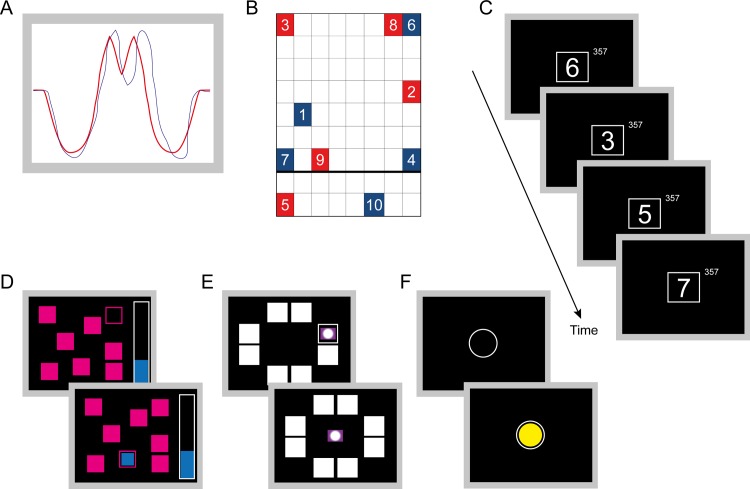Fig 1. Motor skill and cognitive tests.
(A) Fine motor skill–visuomotor accuracy tracking (VAT). The children were instructed to track, as accurately as possible, a fixed target (red line) by using a computer mouse to control the vertical position of a moving trace (blue line). (B) Gross motor skill–stage 3 of the coordination wall. The children had a red dot on the right hand and a blue on the left hand, and were instructed to touch the numbers from one to ten in the correct order with the hand (above the thick line) or foot (below) matching the colour of the number as fast as possible. (C) Rapid Visual Information Processing (RVP) measured sustained attention. A white box appeared in the centre of the computer screen, inside which digits, from 2 to 9, appeared in a pseudo-random order at the rate of 100 digits per minute. Children were requested to press a button on the press-pad when the target sequence (3-5-7) appeared. (D) Spatial Working Memory (SWM). The child had to search for a blue token hidden inside one of the coloured boxes shown on the screen. The number of boxes was gradually increased from three to eight. The outcome measure used here was total number of errors (touching boxes that have been found to be empty or revisiting boxes that have already been found to contain another token). (E) Paired Associates Learning (PAL). Boxes displayed on the screen were opened in a randomised order. Two or more of them contained a pattern. The patterns were then displayed on the screen, one at a time, and the child had to touch the box where the pattern was originally located. If the child made an error, the boxes were opened again, one at a time, to remind the child of their location. (F) Simple Reaction Time (RTI). The child had to react as soon as the yellow dot appeared on the screen by letting go of the press-pad button and pressing the screen where the dot appeared.

